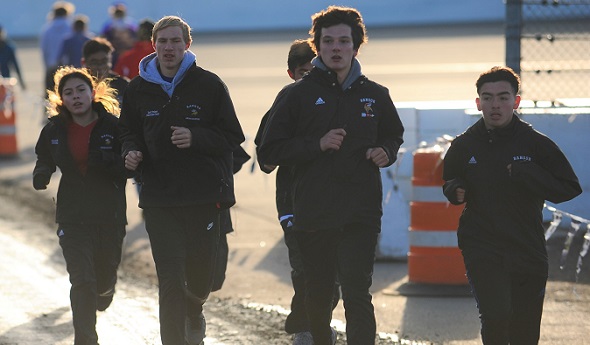
Workout Basics: Warm-Ups & Cool-Downs
February 3, 2021
By Nick Parkinson, M.Ed., AT, ATC, TSAC-F
Henry Ford Health Systems
You may know a good warm-up — and cool-down — are essential to getting a good workout. You may also know that warming up your muscles and stretching them out after exercise can help prevent injury and keep you at the top of your game.
They’re the two bookends that help maximize a workout. Unfortunately, a lot of exercise enthusiasts don’t know how to warm up and cool down correctly.
Warm-Up Basics
A warm-up is exactly what it sounds like: The goal is to warm up your muscles and prepare your body for whatever you’re asking it to do. Warming up increases your body temperature and helps blood flow to the muscles that you’re using.
So if you’re going to play soccer, your warm-up should touch all of the muscles in your legs and core. Shooting hoops? You’ll need to add shoulders and arms to your routine. Circuit training at the gym? Choose a warm-up that flexes all of the muscles you’re about to use.
The thing that all warm-ups have in common is that they require dynamic (or constantly moving) motion, not static stretching (holding poses for a certain amount of time). In fact, static stretching prior to a workout can inhibit power and strength, especially if you’re doing something like weightlifting.
The anatomy of a solid warm-up:
• Before any activity, do about 10 minutes of light cardiovascular activity, whether walking, biking or jogging.
• Dynamic stretches. After you get your muscles moving, do a series of lunges, jumping jacks or toe touches to stretch a bit.
• Dive in. When you start your workout, begin slowly and gradually increase power and speed.
Cool-Down Basics
After you’ve put your body through a challenge, a good cool-down is essential. It helps slow down your heart rate gradually, relax your muscles and stretch them out.
Cool-down routines should always include some type of motion before you get to static stretching, especially if you’ve just finished a high-intensity workout. Static stretching improves flexibility and performance and it can also help stave off future injury.
As with warm-ups, the right cool-down exercises depend on the activity you engaged in. If you biked for 20 miles, you might coast on your cycle for a while before coming to a stop. If you ran, you might jog or walk before you begin stretching. As with your warm-up, the key is addressing every muscle group you worked during your workout.
The anatomy of a solid cool-down:
• At the end of your workout, slow the pace and intensity of whatever activity you’re doing. So, if you’re running, slow to a jog and then a walk for 5 to 10 minutes before stopping.
• Stretch out the muscles you work, but don’t push past the point where you feel tight. Then, hold the position for at least 30 seconds. That’s how long it takes for the body to overcome its stretch reflex.
• Breathe through your stretches and make sure to finish your cool-down with deep, belly breaths.
Running short on time? Target muscle groups you may have injured in the past or that tend to get sore after activity. Cooling down will preserve your athleticism — and your ability to participate in daily activities — over the long term.
Be Good to Your Body
While there’s some controversy about whether warming up and cooling down can help prevent injury, there’s little dispute that they can help you ease in and out of activity.
The key is to find something that works for you. Your warm-up could be as simple as walking to the gym and doing a set of jumping jacks when you arrive. Your cool-down might just involve ending your workout 10 minutes early so you can slow down.
It doesn’t have to be complicated. It just has to give your heart and blood vessels a chance to breathe before and after activity.
Nick Parkinson, M.Ed., AT, ATC, TSAC-F, is the Supervisor of Athletic Training with Henry Ford Sports Medicine and also leads Sports Performance training at the William Clay Ford Center for Athletic Medicine. Learn more about Nick.
Want to learn more? Henry Ford Health System sports medicine experts are treating the whole athlete, in a whole new way. From nutrition to neurology, and from injury prevention to treatment of sports-related conditions, they can give your athlete a unique game plan.
Visit henryford.com/sports or call (313) 972-4216.

Century of School Sports: MHSAA Work Guided by Representative Council
By
Geoff Kimmerly
MHSAA.com senior editor
December 3, 2024
One of the most common misconceptions about the MHSAA over its 100-year history is that all decisions regarding school sports in Michigan are made by the staff in the East Lansing office.
The MHSAA truly is an organization built upon its membership, with its Representative Council the legislative body that has produced the rules and tournament schedules currently in place to provide structure in athletics for more than 750 high schools and hundreds more middle schools across the state.
The Representative Council is the 19-member legislative body of the MHSAA. All but five members are elected by member schools. Four members are appointed by the Council to facilitate representation of females and minorities, and the 19th position is occupied by the Superintendent of Public Instruction or designee.
The Council considers all proposals brought before it from MHSAA sport and other appointed committees that meet throughout the year, and also makes decisions on a variety of eligibility rules, postseason tournament and operational issues. The Council regularly considers 30 committee proposals during its Spring meeting alone, along with a handful of others during Fall and Winter meetings which otherwise are primarily opportunities for discussion of topics that may come up for action at a later date.
Eight representatives are elected across four regions – two apiece from the Northern Lower Peninsula, Southeastern Michigan, Southwestern Michigan and the Upper Peninsula – and also based on school enrollment, with one representative from each of those regions from the larger Class A and B-sized schools and one representative from each region from the smaller Class C and D-sized schools. There are also two statewide at-large positions, two representing junior high/middle schools, and elected representatives from Detroit Public Schools and private and parochial schools.
All Representative Council members must be representatives of a member school, as faculty or board of education members. Every Council candidate must have superintendent or principal approval in writing and be qualified for the position for which that person is running.
Elections take place every fall after names of candidates are submitted and published to the MHSAA Website by April 15 the preceding spring. Ballots are mailed to schools in September and must be postmarked no later than two weeks after they were sent by the MHSAA office. A Board of Canvassers appointed annually counts the ballots, which must be signed by the principal and superintendent of that member school (except for private and parochial schools, which require signature by the principal only).
Council members are selected by majority vote.
Terms for elected Council representatives are two years long. Appointed members also serve two-year terms and may not serve longer than two successive terms.
The Council meets three times annually. Council officers – president, vice president and secretary-treasurer – are elected during the Fall meeting for the full Council.
Five members of the Council also convene monthly during the school year to form the MHSAA’s Executive Committee, which reviews appeals of Handbook regulations by member schools. Those five include the three elected officers.
Previous "Century of School Sports" Spotlights
Nov. 26: Finals Provide Future Pros Early Ford Field Glory - Read
Nov. 19: Connection at Heart of Coaches Advancement Program - Read
Nov. 12: Good Sports are Winners Then, Now & Always - Read
Nov. 5: MHSAA's Home Sweet Home - Read
Oct. 29: MHSAA Summits Draw Thousands to Promote Sportsmanship - Read
Oct. 23: Cross Country Finals Among MHSAA's Longest Running - Read
Oct. 15: State's Storytellers Share Fall Memories - Read
Oct. 8: Guided by 4 S's of Educational Athletics - Read
Oct. 1: Michigan Sends 10 to National Hall of Fame - Read
Sept. 25: MHSAA Record Books Filled with 1000s of Achievements - Read
Sept. 18: Why Does the MHSAA Have These Rules? - Read
Sept. 10: Special Medals, Patches to Commemorate Special Year - Read
Sept. 4: Fall to Finish with 50th Football Championships - Read
Aug. 28: Let the Celebration Begin - Read
PHOTO The MHSAA Representative Council and Executive Director Mark Uyl (front row, far right) take a group photo during its Spring Meeting in May. (Photo by Jon Ross.)


